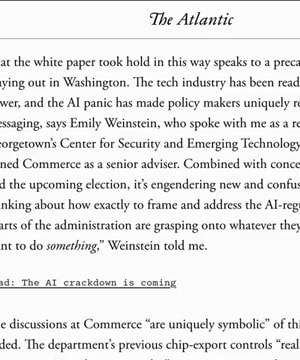AI regulatory problem
Sources:
The problem of regulating AI is multifaceted and involves considerations about competitiveness, security, technical feasibility, and the diversity of the AI landscape. Here are some key points covered by experts:
-
Competitive and Policy Challenges:
- AI regulation is complex due to dynamic tensions within global leadership and economic competition, especially between major players like the US and China. Regulatory actions intended to curb AI advancements in China, such as export controls, can compel US administration to seek extended powers possibly leading to an expansion of government authority. This political and technological tug-of-war makes AI regulatory efforts more intricate 1.
-
Government and Policy Implementation:
- There is skepticism about the capability of government bodies, such as the inadequacy perceived in appointing competent leaders for AI oversight roles. The formation of regulatory bodies might be influenced by major corporations, leading to regulations that could stifle innovation and favor established companies over newcomers 2.
-
Consideration of AI Safety and Existential Risks:
- The regulatory vacuum in AI is alarming given the escalation in corporate and national investments in AI, with companies and governments heavily incentivized to push the boundaries of AI technology. This necessitates proactive governmental action to fund and prioritize AI safety research to mitigate potential harmful consequences 3.
-
Cross-Border and Multilateral Regulatory Efforts:
- Effective AI regulation may require cooperative efforts beyond national borders, such as multinational agreements akin to those for bioweapons or synthetic biology, to manage the risks while harnessing the benefits of AI 4.
-
Sector-Specific Impacts and Regulatory Needs:
- Different sectors might need tailored regulatory approaches. For example, finance and healthcare have immediate regulatory concerns due to direct impacts on the public, necessitating transparency and accountability in AI applications 5.
Through these discussions, it becomes clear that AI regulation is not simply a matter of imposing restrictions but navigating a nuanced landscape of innovation, security, ethical considerations, and global leadership dynamics.
RELATED QUESTIONS-


